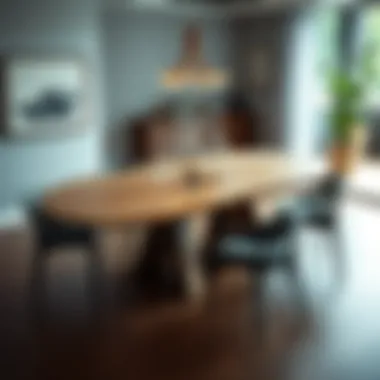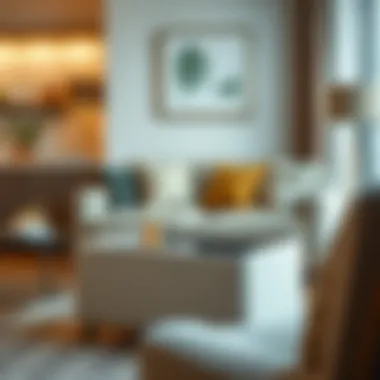Versatile Furniture: Maximizing Space with Style


Intro
In today’s fast-paced world, where space often comes at a premium, the way we think about furniture is changing. Gone are the days of filling rooms with bulky items that serve only one purpose. Instead, there's a growing appreciation for versatile furniture — pieces that adapt and transform to meet our evolving needs. Not only do these designs cater to our practical requirements, they also allow us to maintain a stylish and sophisticated living environment.
Versatile furniture encompasses a wide range of possibilities: from sofa beds and extendable dining tables to ottomans with hidden storage. The significance of this furniture type cannot be overstated, especially for urban dwellers and families navigating small spaces. This article aims to equip readers with insights on key design trends, intelligent selection methods, and an understanding of materials suited for multi-functional usage.
As we dive deeper into this topic, we will explore current trends in furniture design, influential designers making waves in the industry, and some practical tips for making smart furniture choices. Whether you're an interior designer looking for inspiration or a homeowner seeking to optimize your space, this guide will help you illuminate the world of versatile furniture and its potential to transform your living space.
Understanding Versatile Furniture
The world is constantly evolving, and so are our living spaces. Amidst this flow of change, versatile furniture stands as a beacon of practicality and style. Understanding versatile furniture is crucial for anyone looking to navigate the complexities of today’s interior designs. It encompasses an awareness of how these multi-functional pieces not only optimize space but also enhance our lifestyles.
Definition and Concept
Versatile furniture refers to pieces designed with multiple functionalities in mind. These are not just run-of-the-mill items; they represent a thoughtful approach to furniture design that marries form and function. A sofa that transforms into a bed, for instance, offers a practical solution for those living in smaller spaces, ensuring that they can accommodate guests without the need for a guest room.
To put it plainly, it’s about choosing wisely and selecting items that do more than just take up space; they should serve multiple purposes. It’s the kind of furniture that adapts to our needs rather than us conforming to its limitations.
Historical Context
It's interesting to reflect on the historical context of versatile furniture. In past decades, homes often carried a specific identity determined by static furniture pieces. However, as people began moving into smaller apartments and embracing more minimalist lifestyles, the need for functional space became paramount.
The 20th century saw the rise of several influential designers who began to understand this shift, pioneering innovative concepts. For example, iconic pieces like the Murphy bed revolutionized how we view sleeping arrangements. Suddenly, a room could transform into a living space during the day and allow for restful sleep at night. Today, versatility in furniture has truly come of age, thanks to advancements in technology and materials, allowing designs to push creative boundaries even further.
"Versatile furniture embodies an ethos of adaptability, proving that style doesn’t have to compromise practicality."
This modern evolution culminates in a rich tapestry of design that respects not only aesthetics but also functionality. Appreciating this history fosters a deeper understanding of modern design trends, revealing how they stem from our inherent need for flexibility in our personal spaces.
With a clearer grasp of what versatile furniture entails and its evolution over time, one can appreciate the multifaceted nature of modern design. The beauty of these pieces lies not just in their appearance but in their ability to cater to diverse lifestyles, proving that innovation does not have to forsake tradition.
Importance of Versatile Furniture
In today's fast-paced and ever-changing living environments, adaptable furniture has become not just a trend, but a necessity. The significance of versatile furniture lies in its ability to maximize functionality without compromising on aesthetics, which is paramount for modern living. As urbanization continues, many individuals find themselves in smaller homes or apartments. Multi-functional furnishings allow for optimal use of limited space while providing comfort and style.
Space Optimization
Space optimization is one of the core benefits of versatile furniture. Take, for example, a coffee table that transforms into a dining table. Such pieces allow homeowners to entertain guests for dinner without needing a dedicated dining area. This is especially critical in studio apartments, where every square foot counts.
A storage ottoman serves the dual purpose of seating and a place to tuck away miscellaneous items, helping eliminate clutter. In small homes, this concept of dual utility promotes an efficient layout, allowing for smooth movement within the space and preventing it from feeling cramped.
"Maximizing space doesn’t mean sacrificing your style; rather, it calls for innovation in design."
Additionally, in the realm of interior design, versatile furniture encourages creativity in spatial arrangement. Designers can pair modular sofas with extendable tables, ensuring a flow that meets the needs of daily life while remaining visually inviting. Whether converting a workspace into a relaxation nook with fold-down desks or adding multi-functional shelving units, these innovations pave the way for a more dynamic home environment.
Cost Efficiency
Beyond spatial benefits, investing in versatile furniture often translates to significant cost savings. Consumers might initially shy away from the upfront cost of multi-functional pieces, but consider the long-term financial implications. Purchasing a sofa bed, for example, replaces the need for both a couch and a guest room bed, effectively halving expenditures on separate items.
Moreover, in a market swamped with disposable furniture, quality versatile pieces often stand the test of time, making them a more sustainable choice. Opting for durable materials ensures the longevity of these items, further justifying the investment.
Also, when users can easily adapt their living space, they are less likely to feel the urge to redecorate frequently. This not only saves money on new purchases but also reduces the waste associated with discarding less-functional items. Ultimately, versatile furniture can be seen as a wise financial strategy, enabling homeowners to stretch their budgets further while achieving a stylish and functional living space.
Types of Versatile Furniture
Versatile furniture is like the Swiss Army knife of home design; it serves multiple purposes while saving space and enhancing the aesthetic. In today’s crowded living environments, the importance of furniture that can perform double duty cannot be overstated. Each type invites creativity in the way we think about our spaces, merging practicality with style.
By integrating various types of versatile furniture into your living spaces, you can ensure that functionality never takes a back seat to form. Each category discussed below, from sofa beds to foldable desks, holds unique benefits that cater to different lifestyles and needs.
Sofa Beds
Sofa beds epitomize versatility. By day, they perform their duty as a comfortable sofa, inviting relaxation and conversation. At night, they transition seamlessly into a cozy bed. This transformation is especially beneficial in smaller apartments or studios where bedroom space is a luxury.
When selecting a sofa bed, there are several considerations:
- Comfort: Look for a good mattress that doesn't compromise on sleep quality. Some options even come with memory foam mattresses for added comfort.
- Ease of Use: A simple fold-out mechanism avoids frustration at crucial moments.
- Design: Choose a style that complements your decor, matching your aesthetic whether it’s modern, mid-century, or minimalist.
A daily reminder: multi-use furniture does not mean compromising comfort or design.
Extendable Dining Tables
An extendable dining table is a must for those who appreciate both intimate dinners and larger gatherings. It provides the flexibility to expand when family or friends visit, making it ideal for those who frequently entertain. Imagine a table that enhances your daily life only to magically stretch further with minimal effort when the occasion calls for it.
Potential benefits include:
- Space Efficiency: Offsetting the space when not in use can contribute to a more open area.
- Style Variety: These tables come in various materials—wood, metal, and glass—allowing you to align with your home’s theme.
- Durability: Hinges and extension mechanisms are foundational for longevity; consider models known for sturdiness.
Storage Ottomans
Storage ottomans serve as functional decor. They can act as a footrest, a coffee table, and hidden storage all in one. In multi-functional spaces, where every corner counts, those versatile pieces can accommodate everything from magazines to remote controls.
Key aspects to ponder include:


- Capacity: Ensure the internal storage meets your needs; greater storage can keep the living room uncluttered.
- Material and Design: Upholstery affects both comfort and style; choose something that matches your decor and lifestyle.
- Safety Features: Lids that won’t slam shut can be a plus if small children are part of the household.
Foldable Desks and Chairs
Foldable desks and chairs offer an ingenious solution for creating a workspace in limited areas. With remote working becoming the norm, these pieces can provide a designated area that can be neatly tucked away after work hours. The transition from office to living space should feel seamless.
When considering foldable desks and chairs, bear in mind:
- Stability: Make sure the folding mechanism is sturdy; nobody wants a desk collapsing mid-conference.
- Portability: Lightweight options offer flexibility, allowing you to reposition them as needed.
- Aesthetic Appeal: As with all versatile furniture, make sure they feel cohesive within your design vision.
Integrating these types of versatile furniture into your home not only boosts functionality but also contributes to creating an inviting atmosphere. Each piece enhances the livability of your space, allowing you to entertain and relax without the clutter. Surrounding yourself with thoughtful, well-designed items is key to establishing a harmonious living space.
Design Innovations in Versatile Furniture
The landscape of furniture design is rapidly changing, largely due to the increasing demand for pieces that don’t just serve a single purpose. Innovative design in versatile furniture goes beyond mere aesthetics; it captures the imagination while catering to modern needs for efficiency and functionality. In a world where living spaces are often limited, these innovations help create environments that are not just livable but also stylish and smart.
Modular Designs
Modular designs represent a significant leap in how we think about furniture arrangements. The idea is relatively simple but effective: various components or modules can be arranged and rearranged according to needs and preferences. Think of it like a LEGO set but for grown-ups.
These designs allow homeowners to adapt their spaces swiftly. When guests come over, the configuration can change from a cozy seating area to a casual dining setup with just a few rearrangements. Some notable advantages of modular designs include:
- Flexibility: Homeowners can customize their setups without needing to invest in new furniture every time they want a change.
- Space-Saving: Many modular pieces are designed to fit snugly together, maximizing the use of available space.
- Style Versatility: With a wide range of designs and finishes available, modular pieces can complement any decor aesthetic, from minimalistic to eclectic.
However, there are considerations to keep in mind when opting for modular furniture. A crucial factor is ensuring that the system you choose is durable and stable, capable of enduring regular rearrangements without compromising the quality.
Transformable Pieces
Transformable furniture takes versatility a step further. This category includes items that can adapt their form to suit different functions. For example, a coffee table can morph into a dining table, or a sofa can convert into a bed with a bit of maneuvering. The benefits are substantial:
- Multi-Functionality: Every piece serves more than one purpose, making it perfect for compact spaces.
- Inventive Design: Transformable pieces often incorporate clever engineering features, which can be focal points in a room, blending functionality with artistic design.
- Sustainability: Investing in transformable pieces may reduce the need for multiple items, thus lessening the environmental impact associated with furniture production.
Selecting transformable furniture often requires careful consideration of the mechanisms used in the piece to ensure smooth transitions from one function to another. It's important to look for high-quality materials that not only enhance durability but also provide a satisfying user experience.
The rise of modular and transformable furniture reflects a shift towards embracing change, adaptability, and multi-functionality in design.
As we move deeper into the 21st century, the strategies surrounding versatile furniture continue to evolve, presenting endless possibilities for creating elegant and efficient living spaces. A blend of smart design and practical use leads to environments that resonate simplicity and innovation.
Material Considerations for Versatile Furniture
When designing or selecting versatile furniture, the materials used play a critical role in determining not only the aesthetic appeal but also the functionality and lifespan of the pieces. Understanding the properties of different materials helps elevate the utility of multi-functional furniture while ensuring it aligns with both practical needs and style preferences. Factors such as durability, maintenance, sustainability, and overall design should be carefully considered.
Wood vs. Metal: Strengths and Weaknesses
The age-old debate of wood versus metal in furniture design brings different advantages and disadvantages to the table.
- Wood:
- Metal:
- Strengths:
- Weaknesses:
- Aesthetic warmth of wood creates inviting spaces.
- Natural variations in grain make each piece unique.
- Better insulation properties lead to more comfortable furniture.
- Prone to scratches and water damage if not properly treated.
- Can be heavier, making transport difficult.
- Strengths:
- Weaknesses:
- Known for durability; withstands heavy use without bending or breaking.
- Lightweight options available, enhancing adaptability.
- Sleek, modern aesthetic can complement various styles.
- Heat conduction can make metal surfaces uncomfortable.
- Limited warmth in appearance can make spaces feel stark.
Ultimately, the choice between wood and metal will depend on the specific application and aesthetic desire for the intended space. Furniture designers must consider how these materials interact with each other, as they can be combined within a single piece to maximize both functionality and design.
Upholstery Choices and Maintenance
Taking the time to choose the right upholstery is essential for versatile furniture, as it can dictate how the piece performs in daily life. With an array of fabrics available, including natural fibers, synthetics, and blends, here are some considerations:
- Durability: Fabrics designed for heavy use or outdoor settings, such as polyester or acrylic, are often preferable for multi-functional furniture.
- Ease of Cleaning: Stain-resistant materials can save a lot of hassle, especially in family homes where spills are a commonplace.
- Comfort: Choices such as cotton or wool can enhance comfort but may require more meticulous care, while synthetic options might feel less inviting but are extremely durable.
- Color and Pattern: Consider the impact on the room’s overall design; a bold pattern can serve as a focal point but might also limit future room updates.
- Microfiber, for example, provides a soft finish and is easy to maintain.
- A balance is often required here, especially where functionality and aesthetics must overlap.
It's crucial to select upholstery not just for how it looks, but also for how well it will stand up to the daily rigors of life. Choosing wisely helps maintain the integrity and appeal of versatile furniture over time.
Sustainability in Material Selection
As eco-consciousness permeates design choices, sustainability emerges as a key consideration in material selection for versatile furniture. Many manufacturers now prioritize sustainable practices by selecting eco-friendly materials and employing production methods with minimal environmental impact. Here are some strategies that can contribute to sustainable furniture design:
- Reclaimed Wood: Utilizing previously used wood reduces deforestation and adds unique character.
- Bamboo: A fast-growing resource, bamboo is a renewable material that’s both strong and lightweight.
- Non-Toxic Finishes: Opting for natural finishes and adhesives free from harmful chemicals ensures healthier indoor air quality.
- Sourcing: Supporting local artisans not only reduces transportation emissions but also strengthens community economies.
Incorporating sustainable materials into versatile furniture design helps create pieces that are not only functional but align with an ethical vision for environmental stewardship. Making these mindful choices can enhance the appeal of furniture while promoting a greener future.


By thoughtfully selecting materials, designers and consumers can foster a space that respects both individual style and the planet.
Aesthetic Considerations in Versatile Furniture
When delving into the realm of versatile furniture, aesthetics play a pivotal role. The blending of beauty and functionality can transform a mundane environment into a stylish oasis while making the best use of limited space. Striking the right balance between aesthetics and utility ensures that each piece not only serves a purpose but also enhances the overall decor of a home.
A well-thought-out aesthetic can evoke emotions, create atmosphere, and foster an inviting space. Therefore, selecting versatile furniture that complements existing decor styles becomes paramount—not just for visual appeal but also for creating a cohesive home environment.
Balancing Style and Functionality
Finding harmony between style and functionality is crucial in versatile furniture design. On one hand, you want pieces that make a statement, and on the other, they must meet specific needs without sacrificing comfort or practicality. Consider a sofa bed that looks chic yet can easily transition from a seating area to a sleeping space; this duality is what elevates such furniture.
Some of the elements to take into account:
- Design Inspiration: Delve into sources like interior design magazines or platforms such as Pinterest for fresh ideas on how to integrate style into your functional furniture choices.
- Material Selection: Choose textures and finishes that not only fit your aesthetic but are durable and easy to maintain. Upholstered furniture should resist spills and stains, especially in high-traffic areas.
- Form and Proportion: Oversized furniture can often dominate a space. Make sure that the proportions of versatile pieces fit well within the room layout to maintain a flowing aesthetic.
Color and Pattern Selection
The color and pattern selection elements can significantly impact the perception of space and mood. Choosing colors wisely can either open up a room or make it feel cramped. For instance, light colors often create a sense of airiness and spaciousness, while dark colors can add depth but may constrict the feel of a room.
Here are some practical tips:
- Complement Existing Aesthetics: Ensure that the colors and patterns you select for versatile furniture match or blend well with your existing color palette. This cohesion can anchor the design and create a unified look.
- Use Patterns Sparingly: If you are leaning toward bold patterns, consider using them for smaller items like accent chairs or ottomans, rather than statement pieces like sectionals or main seating areas. This approach keeps the room vibrant without overwhelming it.
- Subjective Preference: Stay true to your style, whether it’s eclectic, minimalist, or classic. Your choices should reflect your personality, creating a space that feels like home.
"A well-designed room offers both functionality and an array of aesthetic that comforts the soul and conducts ease of living."
By thoughtfully considering these aesthetic factors, one can create a space that not only supports daily activities but also resonates with the individual's taste, confirming that versatile furniture doesn’t need to compromise on style.
Trends Shaping the Future of Versatile Furniture
The realm of versatile furniture is witnessing a transformation, characterized by innovative trends that merge functionality with modern aesthetics. With the dynamics of urban living evolving, it's imperative to adapt and create spaces that are not just visually appealing but also optimize functionality. This section delves into two pivotal trends: the integration of smart technology and the pervasive influence of minimalism.
Smart Technology Integration
In today’s fast-paced world, smart technology integration stands as a beacon of innovation in versatile furniture. The concept transcends traditional designs, ushering in an era where furniture not only serves practical purposes but also enhances the quality of life. Imagine a coffee table that doubles as a charging station for your devices, or a bookshelf equipped with built-in wireless speakers. Such smart solutions are not merely gimmicks; they represent a significant leap towards convenience and adaptability.
One notable aspect of this advancement is the way smart furniture accommodates our increasingly tech-driven lifestyles. For instance, automated recliners that adjust to individual preferences or sofas with integrated USB ports not only save space but also streamline our daily interactions with technology. The benefits are myriad:
- Increased Efficiency: Smart furniture can solve basic problems—like having a power outlet at arm's reach while lounging.
- Enhanced Comfort: Customizable settings allow users to personalize their space based on immediate needs, fostering a sense of ownership and satisfaction.
- Space-Saving: By combining multiple functions into a single product, residents can maximize their limited square footage, which is a game-changer in urban settings.
As home automation gains traction, the expectation is that furniture will become more responsive to the needs of inhabitants, seamlessly integrating into our daily lives.
Minimalism and Its Influence
Neat lines, simple forms, and functionality define the current trajectory of minimalism in versatile furniture design. Moving away from excessive ornamentation, minimalism emphasizes the "less is more" philosophy, focusing on essential forms that perform well without overwhelming the senses. This trend resonates deeply with homeowners and designers who seek simplicity paired with elegance.
The appeal of minimalism is multi-faceted:
- Clarity in Design: Clean, uncomplicated designs make it easier to coordinate and furnish spaces without clutter.
- Flexibility: Minimalist furniture often transitions more smoothly between different roles in a home—think of a sleek, foldable dining table that can easily serve as a workspace or a family gathering spot.
- Mindful Living: As society leans toward sustainability and intentionality, minimalism advocates for conscious consumption, urging people to invest in quality over quantity.
Embracing minimalism also paves the way for greater adaptability in interior spaces. For example, pieces like nesting tables or modular shelving units allow users to reshape their living areas based on immediate needs without compromising aesthetics.
"Minimalism isn’t about losing everything; it’s about gaining the freedom to enjoy what truly matters."
Incorporating Versatile Furniture into Your Space
In modern living, the blend of style and practicality is essential. By incorporating versatile furniture into your space, you can create multifunctional areas that cater to diverse needs. This approach not only maximizes functionality but also enhances the aesthetic appeal of your home. It's about making smart choices that adapt to your way of life.
Assessing Room Layout
Before you can effectively incorporate versatile furniture, it's crucial to evaluate your room layout. This step is like laying the groundwork for a solid foundation. Begin by measuring your space accurately. It's surprising how often a simple miscalculation can lead to unexpected challenges. Consider the flow of movement within the room. You want to ensure that your pieces don’t just fit, but also serve purposefully. For instance, a sofa bed may take up more space but offers the advantage of transforming a living room into a guest room with ease.
Also, take stock of natural light. Certain furniture types can block light if not positioned correctly, which might make the area feel cramped or uninviting. Ideally, you should opt for lighter colors or materials that reflect light. This could enhance the room's openness. By prioritizing these factors, you can harmonize furniture placement with the room's intended use.
Practical Tips for Arrangement
Once you’ve assessed the layout, it’s time to get into the nitty-gritty of arrangement. Here are some pointers to guide you:
- Group Similar Items Together: Cluster your pieces based on functionality. For instance, place your sofa bed near a coffee table, creating a cozy spot for relaxation.
- Use Multi-Functional Furniture: Invest in items like storage ottomans that double as seating. This not only saves space but also keeps your living area tidy.
- Maintain Clear Pathways: Leave sufficient space between furniture pieces to allow easy movement. A good rule of thumb is to have at least 18 inches between seating areas.
- Layering Textures: Mixing different materials, such as a wooden dining table with upholstered chairs, can create visual interest. This adds depth and character to your arrangement.
- Consider Height Variation: Use furniture of varying heights to create a dynamic look. A tall bookshelf beside a low sofa can add interesting visual layers.
Remember, the key to a successful arrangement is functionality, so prioritize comfort and ease of movement over strict symmetry.
In summary, incorporating versatile furniture requires a keen eye for layout and arrangement. By assessing your room and arranging thoughtfully, you can transform your space into a beautiful and functional haven. With careful consideration of your choices, you'll find that versatile furniture not only meets your needs but also enhances your lifestyle.
Challenges in Choosing Versatile Furniture
When it comes to selecting versatile furniture, potential buyers often encounter two prominent barriers: the balance between quality and affordability, and the constraints posed by space limitations. Each of these challenges plays a critical role in shaping decisions, ultimately affecting the functionality and aesthetic appeal of your living space.
Quality vs. Affordability
Striking a balance between quality and affordability poses a significant challenge for many. On one hand, high-quality pieces boast durability, craftsmanship, and often a timeless style. However, these can come with a hefty price tag. For instance, while you might find a sleek sofa bed made from premium materials at a designer store, it could take a sizeable bite out of your budget.


Conversely, there are budget-friendly options available that prioritize cost over craftsmanship, which may lead to quicker wear and tear. For example, a well-reviewed extendable dining table from a major retailer might not hold up as well as its pricier counterparts after several years of use. This trade-off forces consumers to ask themselves serious questions:
- How often will I use this piece?
- Am I willing to invest more for longevity?
- What is my style preference, and does it align with the price of quality pieces?
Ultimately, it's about finding that sweet spot. Prioritizing furniture that offers practical usage along with decent quality ensures that your investments deliver value in both performance and aesthetics over time.
Space Limitations
Space limitations can be a real headache, especially for city dwellers in compact apartments. When your living area is little more than a shoebox, every square inch counts. The challenge increases when trying to integrate versatile furniture, which should simplify and enhance the space, not complicate it further.
One approach is to carefully assess the room layout before making purchases. You might want to consider a folding dining table that expands when needed, or a storage ottoman that doubles as seating. These options can help you make the most of your environment while still delivering on the function.
Here are some aspects to consider regarding space limitations:
- Measure before you shop: Know your available space and how each piece will fit in.
- Think vertically: Utilize wall shelves or stackable chairs to maintain floor space.
- Be mindful of movement: Choose furniture that allows for easy flow between areas; a piece that’s too large can block paths and create a cramped feeling.
Remember, versatile furniture should enhance your lifestyle, making it easier to adapt spaces as your needs change.
Choosing the right versatile furniture means navigating these challenges with care. Keeping a focus on quality alongside budget considerations, and being strategic in dealing with space limitations, can lead to a home that’s both functional and stylish. The right choices can transform your living situation into a well-organized and attractive space rooted in practicality.
Evaluating Versatile Furniture Products
In today's fast-paced world, the notion of space is evolving. Homes are often turned into multi-functional havens where every square foot counts. Consequently, evaluating versatile furniture products becomes a pivotal consideration. Understanding what to look for can save time, money, and enhance living experience. This section will cover essential aspects to consider when selecting versatile furniture, ensuring it meets both functional and aesthetic needs.
Key Features to Look For
When considering versatile furniture, there are several hallmark features that elevate a product’s practicality and appeal. Here’s a breakdown of what to keep in mind:
- Functionality: Always ensure that the item serves multiple purposes. For example, a sofa bed should be comfortable to sit on as well as sleep on.
- Durability: Look for robust materials that withstand wear and tear, particularly in high-traffic areas.
- Ease of Use: Opt for designs that allow for quick transformation or adjustments. This could be as simple as a table that expands easily without requiring excessive effort.
- Aesthetic Harmony: Ensure the piece fits within your existing decor. A versatile item should complement while remaining functional, not an eyesore.
- Storage Options: Furniture that incorporates storage solutions can help eliminate clutter. Examples include storage ottomans or coffee tables with compartments.
These features not only add value but also contribute to a seamless blend of form and function in your space.
Comparison of Popular Brands
In the realm of versatile furniture, numerous brands stand out for their innovative approaches and quality offerings. Knowing how they stack up can assist in making informed decisions. Here’s a brief overview of a few notable brands:
- IKEA: Renowned for budget-friendly options that merge style with utility. Their modular systems are designed to cater to diverse needs.
- West Elm: Offers stylish selections that focus on sustainability without sacrificing functionality. Pieces often have dual roles, like tables that double as storage.
- CB2: This brand boasts a modern aesthetic with designs that are both chic and practical. Their furniture often features sleek lines and can serve multiple purposes effectively.
- Resource Furniture: Specialized in high-end, space-saving designs, their products can transform with the flick of a wrist. Perfect for small apartments.
Choosing the right brand means looking beyond just prices. Consider the long-term investment their furniture makes in enhancing both the usability and appeal of your space.
"Investing in versatile furniture is not merely buying a piece but creating environments that adapt to life's ever-changing needs."
Real-life Applications of Versatile Furniture
In today’s fast-paced world, choosing the right furniture can play a huge role in the functionality and overall atmosphere of a living space. Versatile furniture is not just a trend; it’s a necessity for those who seek to maximize their comfort while minimizing clutter. This section sheds light on real-life applications of versatile furniture, demonstrating how these smart designs contribute to an improved living environment and practical solutions.
Case Studies of Successful Designs
Real-world examples show the effectiveness of versatile furniture. For instance, the Murphy bed has long been hailed as a champion of multi-functionality. Once only relegated to small studio apartments, these beds can now be found in family homes, offering a complete guest room when needed, yet folding up to transform a space into a cozy den in a snap.
A notable case involves a family in Seattle that renovated their small cottage utilizing a convertible sofa. This particular design isn’t just about aesthetics; it offers a comfortable seating area during the day while unfolding into a bed at night.
Benefits observed in such cases include:
- Optimized usage of limited space.
- The ability to host guests without sacrificing personal space.
- Enhanced functionality during different times of the day.
Another impressive example comes from innovative coffee tables that come with hidden storage compartments. One family shared how their * lift-top coffee table* has revolutionized their living room. Not only does it serve as a stylish centerpiece, but it also provides ample space for storing games and blankets.
User Experiences and Testimonials
To truly appreciate versatile furniture, it’s essential to listen to those who have incorporated it into their lives. One homeowner shared how their extendable dining table changed their approach to gatherings. "Before, I’d hesitate to invite friends over due to limited space. Now, it’s like a magic trick; the table expands to fit everyone, and I don’t waste a moment worrying about where people will sit," they remarked.
Other stories echo similar sentiments. An interior designer conveyed, "Clients often come to me overwhelmed by choices, but once they see how much multi-functional furniture can simplify their spaces, they're all in. They love how a foldable desk, for example, seamlessly integrates into their home office and can vanish when not in use."
Such testimonials highlight the seamless integration of furniture in enhancing daily life, alleviating stress related to space limitations, and inspiring creativity in how to entertain or relax at home.
"Versatile furniture is not simply a trend; it’s a shift in how we conceptualize our living spaces. It’s about reclaiming space and creating areas that feel just right for each task."
In essence, the success stories of those who've embarked on this journey illustrate a key point: choosing versatile furniture can unlock a plethora of possibilities within the confines of one's home.
The End
In wrapping up our discussion on versatile furniture, it’s vital to reflect on how these multi-functional designs address modern living needs. The essence of versatile furniture lies in its ability to blend practicality with style. This adaptation not only caters to spatial restrictions but also reflects a progressive approach towards home aesthetics in an increasingly urbanized world. No longer do we have the luxury of sprawling estates; instead, every square foot counts, and versatile furniture emerges as a savvy solution.
Summary of Key Insights
To summarize, several profound insights have emerged throughout this exploration:
- Adaptability is Key: Versatile furniture evolves with our lifestyles. Whether it's a coffee table transforming into a dining surface or a sofa that shifts into a bed, these pieces provide flexibility and meet multiple needs.
- Space Utilization: In today’s smaller homes, optimizing every inch is essential. Multi-functional furniture helps eliminate the clutter and enhances utility without compromising on aesthetic appeal.
- Economic Sense: Investing in quality versatile pieces often saves money in the long run. Fewer purchases mean reduced expenses on additional furniture, and these items typically last longer due to their solid construction.
- Innovative Designs: Modern technology and creative design trends breathe new life into versatile furniture. Users can now find pieces that are not only functional but also distinctly stylish, reflecting individual tastes.
Future Directions in Versatile Furniture Development
Looking ahead, the future of versatile furniture appears bright and brimming with potential. Several trends are notable:
- Smart Technology Integration: Expect to see more furniture equipped with smart capabilities, such as desks that adjust height automatically or sofas with built-in charging ports. This tech-savvy approach will cater to the rising demand for connectivity.
- Sustainable Practices: As eco-consciousness grows, the development of versatile furniture will likely lean toward sustainable materials and ethical production methods. Consumers are becoming more aware of their environmental impact, which will drive manufacturers to adopt greener practices.
- Customization Options: Personalization is primed to take center stage. Future designs may allow consumers to customize their furniture based on specific needs, like size, color, and function, further enhancing user satisfaction.
- Focus on Health and Well-being: Environments that promote health will gain traction. Furniture that supports posture, promotes movement, and leads to healthier living will be integral in future designs.
As these trends materialize, the concept of versatile furniture must remain adaptable to fit the ever-changing dynamics of our lives. This adaptability isn't just about facing challenges; it’s about thriving amid them.



